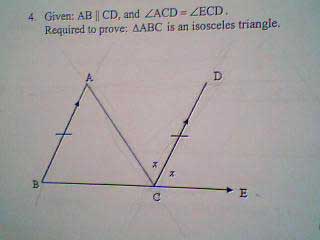| |||
| Math Central | Quandaries & Queries |
|
I am stuck on this problem... If AB = CD (parellel line), and <ACD = <ECD. I need to prove that the triangle ABC is isosceles. I cannot draw from my computer therefore if you need more details let me know. |
Lias continued.
I was able to take a pic with my web cam so you'll get full details on the pic since I don't know how to draw you the pic.

Hi Lisa.
1. Corresponding angles formed by a transverse line crossing two parallel lines are congruent, therefore angle CAB equals angle ACD and that's x in your diagram.
2. For similar reasons, angle ABC equals angle DCE and that's also x.
The final step is connected to another problem you sent us.
Question from Lisa, a student:
This is a fill in the blanks that I just do not understand.
The (blank) angle of a triangle is equal to the sum of the (blank) opposite angles.
Can you formalize this and complete the proof?
The
Stephen and Penny
PS: Your web camera really helped!
 |
||
Math Central is supported by the University of Regina and The Pacific Institute for the Mathematical Sciences.